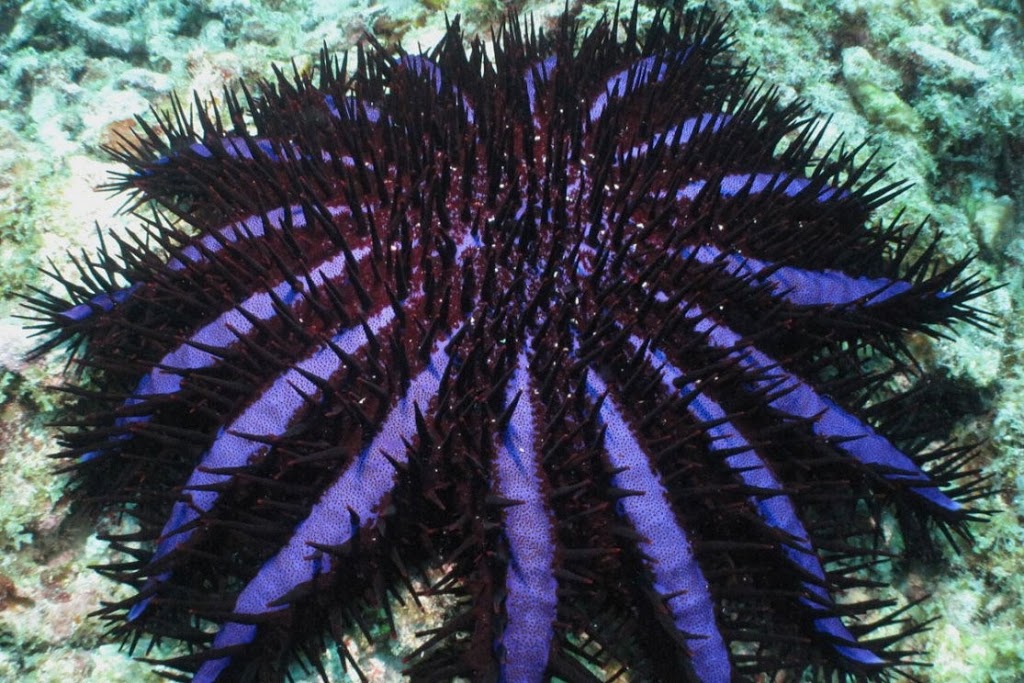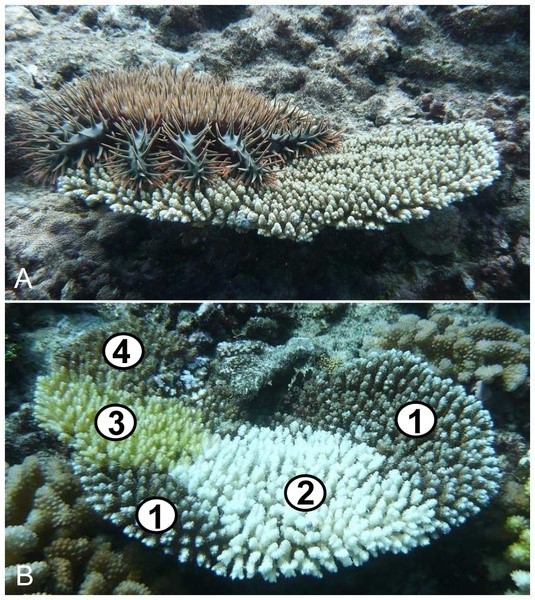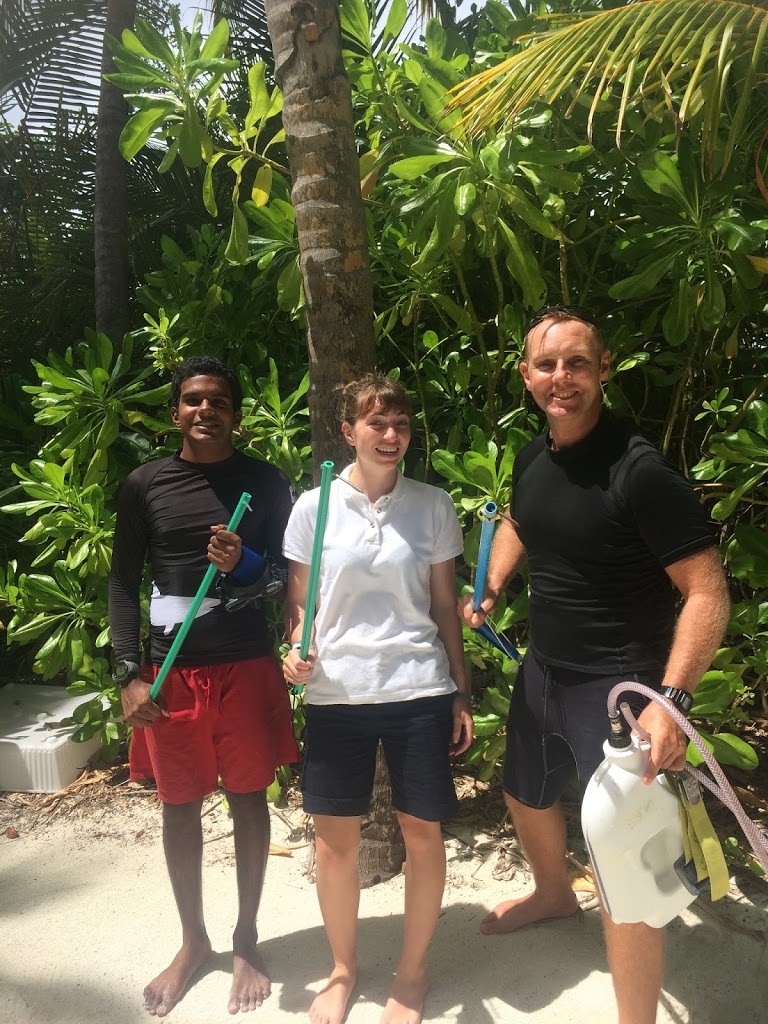As the corals of the Maldives are already vulnerable our understanding and removal efforts of the crown of thorns starfish is paramount to the health of our reef.
Everyday Gili Lankanfushi has sightings of the voracious crown-of-thorns starfish (COT) Acanthaster planci. Native to coral reefs in the Indo-Pacific region and the largest species of starfish (Asteroidea), they are generally seen at depths of up to 30 metres. However, they have also been known to travel between Atolls at great depths of around 200m. There are four species of COT, but it is A. planci which is responsible for coral mortality in the Northern Indian Ocean and the coral triangle. COTS are corallivores and during optimal conditions can grow to over half a meter in diameter and have more than 30 arms.
Everyday Gili Lankanfushi has sightings of the voracious crown-of-thorns starfish (COT) Acanthaster planci. Native to coral reefs in the Indo-Pacific region and the largest species of starfish (Asteroidea), they are generally seen at depths of up to 30 metres. However, they have also been known to travel between Atolls at great depths of around 200m. There are four species of COT, but it is A. planci which is responsible for coral mortality in the Northern Indian Ocean and the coral triangle. COTS are corallivores and during optimal conditions can grow to over half a meter in diameter and have more than 30 arms.
 |
| Crown of Thorns |
Generally COTS can be considered a keystone species because they can maintain healthy coral reef diversity by primarily feeding on fast growing corals, such as staghorn and plate (Acropora sp.) and enable the slower massive corals to establish and develop. When coral coverage is low, often resulting from COT outbreaks, COTS will eat Porites, Montipora, sponges, algae and encrusting organisms. One COT can consume all the coral in a 6 to 10m square radius annually, so the impact on an already vulnerable reef is catastrophic. The feeding behaviour is dependent on population density, water motion and species composition. COTS are covered in venomous spines coated with saponin which causes irritation and pain at a puncture wound. The spines are long, sharp and lowered to avoid drag.
Fossil evidence suggests that COTS developed millions of years ago. However, COT outbreaks have only occurred in the last 60 to 70 years and with increasing frequency and intensity. The first recorded outbreak occurred in the 1950s in the Ryukyu Islands off Japan. Combined with anthropogenic threats and other stresses outbreaks are greatly detrimental to coral reef survival and the fish associated with the reef.
 |
| Crown of Thorns destruction: 1 – healthy coral, 2 – freshly killed coral, 3 – recently killed portion colonised by algae and bacteria, 4 – long dead coral |
COT outbreaks in the Maldives are relatively recent; the first recorded outbreak was in the 1970’s, the second in the 1990’s. Currently we are experiencing an outbreak which started in 2013. It began in North Male Atoll and has spread through to Ari Atoll, Baa Atoll, Lhaviyani Atoll, South Male Atoll and large densities have recently been documented in Shaviyani Atoll.
Outbreaks result for a variety of reasons. Firstly, when there is an excess of nutrients entering the water as a consequence of runoff from sewage, fertiliser and other island practices. The resulting eutrophication leads to increased plankton for the COT larvae and decreased juvenile mortality. Secondly, loss of COT predators; napoleon wrasse, lined worm, harlequin shrimp, starry puffer fish, titan and yellow margin triggerfish and triton’s trumpet (red and spangled emperor and parrotfish have been known to feed off young COTS before they have spines).
 |
| COT being predated upon by Triton’s Trumpet. |
Loss of predators occurs due to overfishing for the souvenir trade, bycatch and habitat destruction. This leads to a drop in already low predation pressure and results in a COT population surge. Finally, COTS have excellent adaptations as they are resilient organisms with an R selected life history (high growth rate, typically exploit less crowded ecological niches and produce many off spring). COT females can produce 65 million eggs annually between October to February. The eggs are released into the water column and are fertilized by clouds of sperm from nearby males. After fertilisation larvae are in their planktonic form and remain that way for weeks. After settling on the sea floor and developing into their adult form they develop their spines and start feeding off coral. This process can take around a year. COTS are most vulnerable before their spines are developed. Additionally, they can survive between 6 to 9 months without food, and body parts lost due to stress or predation can regenerate within 6 months.
Short and long term methods are being established around the world to minimise the effects of current outbreaks and to help prevent future outbreaks. The marine biology team at Gili Lankanfushi is focused on the removal of COTS. Our primary aim is removing these creatures from the overwater villas and jetty’s. Guests and hosts report sightings of COTS, and our team of marine biologists will remove them by injecting them with vinegar. This method is labour intensive and is carried out as regularly as possible by both the Marine Biology team and the Dive Centre. For more information or to report a COT sighting, please follow this link.
 |
| Marine Biologist, Emma and Dive Team members Harvey and Layyan preparing to eradicate COTs on our House Reef |
Written by Emma Bell